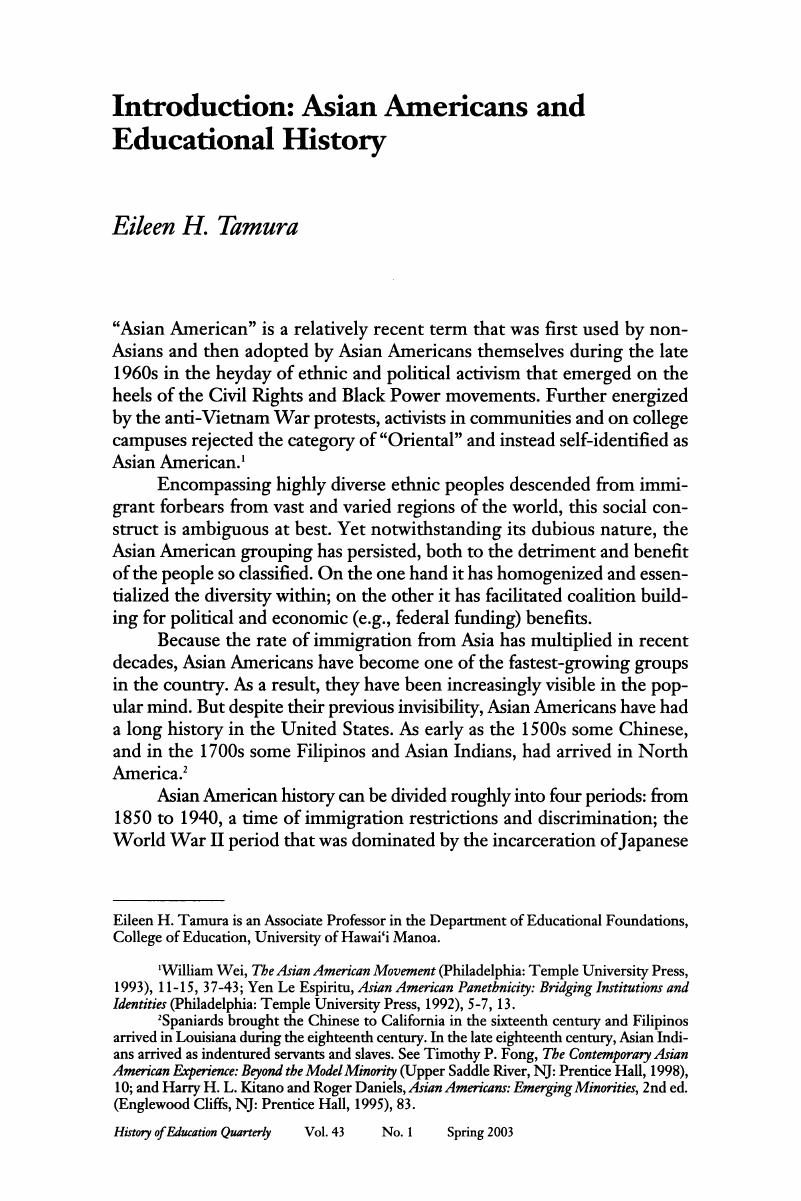Published online by Cambridge University Press: 24 February 2017

1 Wei, William The Asian American Movement (Philadelphia: Temple University Press, 1993), 11–15, 37–43; Yen Le Espiritu, Asian American Panethnicity: Bridging Institutions and Identities (Philadelphia: Temple University Press, 1992), 5–7, 13.Google Scholar
2 Spaniards brought the Chinese to California in the sixteenth century and Filipinos arrived in Louisiana during the eighteenth century. In the late eighteenth century, Asian Indians arrived as indentured servants and slaves. See Timothy P. Fong, The Contemporary Asian American Experience: Beyond the Model Minority (Upper Saddle River, NJ: Prentice Hall, 1998), 10; and Harry H. L. Kitano and Roger Daniels, Asian Americans: Emerging Minorities, 2nd ed. (Englewood Cliffs, NJ: Prentice Hall, 1995), 83.Google Scholar
3 Yung, Judy “Chinese,“ in A Nation of Peoples: A Sourcebook on America's Multicultural Heritage ed. Robert Barkan, Elliott (Westport, CT: Greenwood Press, 1999), 119–122; Wong, Morrison G., “Chinese Americans,” in Asian Americans: Contemporary Trends and Issues ed. Pyong Gap Min (Thousand Oaks, CA: SAGE Publications, 1995), 59; Fong, The Contemporary Asian American Experience, 11.Google Scholar
4 Glick, Clarence E. Sojourners and Settlers: Chinese Migrants in Hawaii (Honolulu: University of Hawaii Press, 1980), x–xi, 12, 18, 23.Google Scholar
5 Wong, “Chinese Americans,“ 63.Google Scholar
6 Tamura, Eileen H. Americanization, Acculturation, and Ethnic Identity: The Nisei Generation in Hawaii (Urbana: University of Illinois Press, 1984), 27; Yuji Ichioka, The Issei: The World of the First Generation Japanese Immigrants, 1885–1924 (New York: The Free Press, 1988), 8–9. An earlier attempt in 1868 to use Japanese laborers in Hawai'i had been largely unsuccessful. See Eileen H. Tamura, “Japanese,” in A Nation of Peoples: A Sourcebook on America's Multicultural Heritage ed. Elliott Robert Barkan (Westport, CT: Greenwood Press, 1999), 311.Google Scholar
7 Hing, Bill Ong Making and Remaking Asian America Through Immigration Policy, 1850–1990 (Stanford, CA: Stanford University Press, 1993), 29; Tamura, Americanization, Acculturation, and Ethnic Identity, 18, 20.Google Scholar
8 For a discussion of how the practice of picture-brides derived from traditional Japanese marriage practices, see Tamura, “Japanese,” 312–313.Google Scholar
9 Tamura, Americanization, Acculturation, and Ethnic Identity, 79.Google Scholar
10 Pyong Gap Min, “Korean Americans,” in Asian Americans: Contemporary Trends and Issues ed. Pyong Gap Min (Thousand Oaks, CA: SAGE Publications, 1995), 200–202; Fong, The Contemporary Asian American Experience, 13.Google Scholar
11 Daniels, Kitano and Asian Americans: Emerging Minorities, 96–97; Manju Sheth, “Asian Indian Americans,” in Asian Americans: Contemporary Trends and Issues ed. Pyong Gap Min (Thousand Oaks, CA: SAGE Publications, 1995), 170–171.Google Scholar
12 Daniels, Kitano and Asian Americans: Emerging Minorities, 83–86.Google Scholar
13 Tamura, Americanization, Acculturation, and Ethnic Identity, 5.Google Scholar
14 Ibid., 27–28.Google Scholar
15 Ichioka, The Issei, 211–226.Google Scholar
16 Tamura, Americanization, Acculturation, and Ethnic Identity, 78.Google Scholar
17 Daniels, Roger Coming to America: A History of Immigration and Ethnicity in American Life (New York: HarperPerennial, 1991), 351; Roger Daniels, “No Lamps Were Lit for Them: Angel Island and the Historiography of Asian American Immigration,” Journal of American Ethnic History 17 (Fall 1997): 14.Google Scholar
18 Wong, “Chinese Americans,“ 65–66.Google Scholar
19 Nishi, Setsuko Matsunaga “Japanese Americans,“ in Asian Americans: Contemporary Trends and Issues ed. Gap Min, Pyong (Thousand Oaks, CA: SAGE Publications, 1995), 98–100.Google Scholar
20 Hing, Making and Remaking Asian America, 3 39–41.Google Scholar
21 Min, Pyong Gap “An Overview of Asian Americans,“ in Asian Americans: Contemporary Trends and Issues ed. Gap Min, Pyong (Thousand Oaks, CA: SAGE Publications, 1995), 11–13; Kitano and Daniels, Asian Americans: Emerging Minorities, 18–19.Google Scholar
22 Min, “An Overview of Asian Americans,“ 13 29; Nishi, “Japanese Ameicans,” 100–101; United States Census Bureau, “Race Alone or in Combination for American Indian, Alaska Native, and for Selected Categories of Asian and of Native Hawaiian and Other Pacific Islander: 2000,” American FactFinder, www.census.gov/main/www/cen2000.html, revised January 29, 2002, downloaded March 10, 2002.Google Scholar
23 United States Census Bureau, “Profile of General Demographic Characteristics: 2000,” American FactFinder, www.census.gov/main/www/cen2000.html, revised January 29, 2002, downloaded March 10, 2002; Larry H. Shinagawa, “The Impact of Immigration on the Demography of Asian Pacific Americans,” in Reframing the Immigration Debate, ed. Bill Ong Hing and Ronald Lee (Los Angeles: LEAP and UCLA Asian American Studies Center, 1996), 61.Google Scholar
24 Tape v. Hurley, 66 California 473 (1885); Victor Low, The Unimpressible Race: A Century of Educational Struggle by the Chinese in San Francisco (San Francisco: East/West Publishing, 1982), 60–73; Charles M. Wollenberg, All Deliberate Speed: Segregation and Exclusion in California Schools, 1885–1915 (Berkeley: University of California Press, 1976), 28–43.Google Scholar
25 Asian Americans also went to court to challenge discrimination in non-schooling issues. For a discussion of the struggle to become naturalized American citizens, see Ichioka, The Issei, 210–226. For a discussion of the challenge to discriminatory land laws, see ibid., 153–56, 226–43; and Roger Daniels, Asian America: Chinese and Japanese in the United States since 1850 (Seattle: University of Washington Press, 1988), 141–47.Google Scholar
26 Spickard, Paul R. Japanese Americans: The Formation and Transformation of an Ethnic Group (New York: Twayne Publishers, 1996), 47.Google Scholar
27 The scholarly literature on the incarceration of Japanese Americans during World War II is massive. Those less familiar with this history might begin with publications such as Roger Daniels, Prisoners without Trial: Japanese Americans in World War II (New York: Hill and Wang, 1993); idem, Concentration Camps: North America, Japanese in the United States and Canada During World War II (Malabar, FL: Krieger Publishing, 1993); Jeffery F. Burton, Mary M. Farrell, Florence B. Lord, and Richard W. Lord, Confinement and Ethnicity: An Overview of World War II Japanese American Relocation Sites (Tucson, AZ: Western Archeological and Conservation Center, National Park Service, 1999); and Commission on Wartime Relocation and Internment of Civilians, Personal Justice Denied (Washington, D.C. and Seattle: The Civil Liberties Public Education Fund and University of Washington Press, 1997).Google Scholar
28 Okihiro, Gary Margins and Mainstreams: Asians in American History and Culture (Seattle: University of Washington Press, 1994), 151, 155, 175.Google Scholar
29 Tamura, Eileen H. “Asian Americans in the History of Education: An Historiographical Essay,“ History of Education Quarterly 41 (Spring 2001): 58–71.Google Scholar